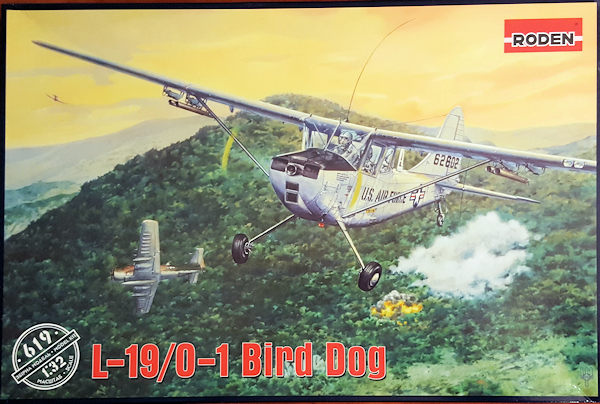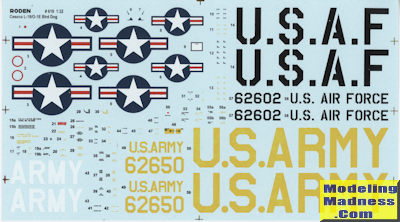
Roden 1/32 O-1 Bird Dog
| KIT #: | 619 |
| PRICE: | $60.00 SRP |
| DECALS: | Two options |
| REVIEWER: | Scott Van Aken |
| NOTES: | 2016 New tool kit. |

| HISTORY |
The United States Department of Defense (DOD) ordered 3,200 L-19s that were built between 1950 and 1959, entering both the U.S. Army and U.S. Marine Corps inventories, initially designated as OE-1s in the Marine Corps until all US military aircraft designations were standardized in 1962. The aircraft were used in various utility roles such as artillery spotting, front line communications, medevac and training.
In 1962, the Army L-19 and Marine Corps OE-1 was redesignated the O-1 (Observation) Bird Dog and entered the war in Vietnam. During the early 1960s, the Bird Dog was flown by South Vietnamese (ARVN-Army Republic Vietnam/SVAF South Vietnamese Air Force), U.S. Army, and U.S. Marines in South Vietnam and later by clandestine forward air controllers (e.g., Ravens) in Laos and Cambodia. Because of its short takeoff and landing (STOL) and low altitude/low airspeed capabilities, the O-1 also later found its way into U.S. Air Force service as a Forward Air Controller (FAC) aircraft for vectoring faster fighter and attack aircraft and supporting combat search-and-rescue operations recovering downed aircrews.
During the Vietnam War the Bird Dog was used primarily for reconnaissance, target acquisition, artillery adjustment, radio relay, convoy escort and the forward air control of tactical aircraft, to include bombers operating in a tactical role.
Supplementing the O-1, then gradually replacing it, the USAF switched to the Cessna O-2 Skymaster and North American OV-10 Bronco, while the U.S. Marine Corps took delivery of the OV-10 to replace their aging O-1s. Both were faster twin-engined aircraft, with the OV-10 being a turboprop aircraft, but the U.S. Army retained the Bird Dog throughout the war with up to 11 Reconnaissance Airplane Companies (RACs) deployed to cover all of South Vietnam, the DMZ and the southern edge of North Vietnam. Its quieter noise footprint, lower speed, tighter maneuverability, short runway ability and better visibility (even to the rear) kept it highly valued by the ground units it supported and highly feared by enemy units it flew over. The last U.S. Army O-1 Bird Dog was officially retired in 1974.
During the course of the Vietnam War, 469 O-1 Bird Dogs were lost to all causes. The USAF lost 178, the USMC lost 7, and 284 were lost from the U.S. Army, South Vietnamese Forces, and clandestine operators. Three Bird Dogs were lost to enemy hand-held surface-to-air missiles (SAMs).
Two O-1 Bird Dogs were loaned to the Australian Army's 161 Reconnaissance Flight operating out of Nui Dat in Phuoc Tuy province. One was lost to ground fire in May 1968, killing 161's commanding officer. Another Bird Dog was built by this unit's maintenance crew, using aircraft sections salvaged from dumps around Vietnam. It was test-flown and later smuggled back to Australia in pieces, contained in crates marked as "aircraft spares". This aircraft now resides in the Museum of Army Flying at the Army Aviation Center at Oakey, Queensland.
As the USAF phased out the O-1 in favor of the O-2 and OV-10, many O-1s in the United States were sold as surplus. During the 1970s and 1980s, Ector Aircraft remanufactured many as the Ector Mountaineer with their original powerplants, and as the Ector Super Mountaineer with the Lycoming O-540-A4B5.
| THE KIT |
 One
thing you will notice is that in this scale, it is a fairly good size kit.
Smaller than your usual single engine fighter, but still a fairly good size.
Molding is excellent and Roden does supply a goodly amount of detail, thanks to
the scale. Though unrelated to the quality of the kit, I found that mine came
with the end of the bag ripped open by the parts jostling around during
shipment. As a result, some pieces had broken free of the sprue and were
rattling around in the box.
One
thing you will notice is that in this scale, it is a fairly good size kit.
Smaller than your usual single engine fighter, but still a fairly good size.
Molding is excellent and Roden does supply a goodly amount of detail, thanks to
the scale. Though unrelated to the quality of the kit, I found that mine came
with the end of the bag ripped open by the parts jostling around during
shipment. As a result, some pieces had broken free of the sprue and were
rattling around in the box.
Much of the initial construction will be in building up the complete six cylinder engine. To be honest, if you close the cowling, you won't see much of this, but one should at least build it up as you can see the forward cylinders and the back where the exhaust exits. It is also required to have a place to hold the prop.
It will be important to ensure that the engine fits properly on the motor mounts or it will be a difficult task to attach all the cowling pieces properly. Roden kits generally have very tight tolerances so be sure the parts are properly cleaned up of attachment points and mold seams prior to building.
There is quite a bit of detail in the cockpit. The front seat is quite well done with a lot of the usual lower bracings. The back seat is simply two pieces that attaches to the sides of the fuselage when closed. The instrument panel could have been enhanced with a nice decal but none is supplied. Having said that, perhaps it is not a bad thing as Roden decals do not have a very good reputation. They are well printed, but don't like setting solutions nor do they like to stick all that well. Fortunately, there is a nice sheet from AOA Decals to rectify that.
Several 1mm holes will need to be drilled for the various antennas. Speaking of which, the shiny bag you see in the photo contains several lengths of metal wire to use for the stab and upper fuselage antennas. The stab antennas are held in place by caps so you have to decide whether to attach these during the normal build or wait until just before painting. All the clear bits will need to be installed prior to or during closing the fuselage halves. There are quite a few of them.
Ailerons and flaps are separate, but are shown in the neutral position. Same for the elevators and rudder. Looking over quite a few period photos of this plane, it was not uncommon to have the elevators slightly drooped. None of the photos showed the flaps down on the ground. For things under the wings, you have four racks which each hold two WP marking rockets. There are shallow divots in the underside of the wing for these. I'd recommend drilling them out a bit more. It was also noted when looking at photos that these planes did not always carry a full complement of rockets. I should mention that the wings are a full span upper piece with two lower halves.
 Instructions
are well done and provide Vallejo color references. No FS 595 colors are
provided, which would have helped as I doubt if many of you use Vallejo for all
your painting. I certainly don't as I've found it requires a primer or it won't
stick all that well and I usually don't prime things like engines and the
interior. Markings are for two planes. One is an OD with Bright Orange areas on
it as flown at the Fort Rucker training school in 1965. The other is the box art
plane based at DaNang in 1966. This USAF plane is in overall ADC Grey.
Instructions
are well done and provide Vallejo color references. No FS 595 colors are
provided, which would have helped as I doubt if many of you use Vallejo for all
your painting. I certainly don't as I've found it requires a primer or it won't
stick all that well and I usually don't prime things like engines and the
interior. Markings are for two planes. One is an OD with Bright Orange areas on
it as flown at the Fort Rucker training school in 1965. The other is the box art
plane based at DaNang in 1966. This USAF plane is in overall ADC Grey.
| CONCLUSIONS |
I bought this kit to use with the AOA decal sheet. I've had fairly good luck with Roden kits, though I know they can be problematic at times. I expect this one to be a fairly clean build, but only the actual building of the kit will say for sure.
| REFERENCES |
https://en.wikipedia.org/wiki/Cessna_O-1_Bird_Dog
January 2017 Copyright
ModelingMadness.com. All rights reserved. If you would like your product reviewed fairly and fairly quickly, please
contact
the editor
or see other details in the
Note to
Contributors.
Back to the Main Page
Back to the Review
Index Page
Back to the Previews Index Page